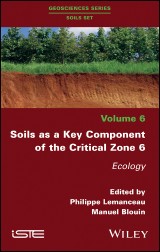Details

Soils as a Key Component of the Critical Zone 6
Ecology1. Aufl.
|
139,99 € |
|
| Verlag: | Wiley |
| Format: | |
| Veröffentl.: | 28.11.2018 |
| ISBN/EAN: | 9781119573128 |
| Sprache: | englisch |
| Anzahl Seiten: | 208 |
DRM-geschütztes eBook, Sie benötigen z.B. Adobe Digital Editions und eine Adobe ID zum Lesen.
Beschreibungen
<p>Soils are environments where a myriad of different organisms evolve, determining a series of functions which translate into ecosystem services that are essential for humanity. Improving our understanding of these organisms, their biodiversity and their interactions with each other, as well as with the environment, represents a major challenge.<br /><br />Soil ecology has its roots in natural history. The ecological approach focused on soils is notable for integrating, at least partially, the contributions of soil sciences (physics, chemistry, biochemistry). By renewing methods of observation and analysis (especially molecular ones) and through the development of experimental approaches and modeling, an ecology connected with other soil-based disciplines emerges and begins to influence aboveground ecology.<br /><br /><i>Soils as a Key Component of the Critical Zone 6</i> presents an updated vision of knowledge and research in soil ecology as a complex system from the best French specialists.</p>
<p>Foreword ix</p> <p><b>Chapter 1. Life in the Soil: From Taxonomy to </b><b>Ecological Integration 1<br /></b><i>Manuel BLOUIN, Philippe HINSINGER, Patrick LAVELLE and Philippe LEMANCEAU</i></p> <p>1.1. Importance of soil organisms 1</p> <p>1.2. Historical perspective 3</p> <p>1.2.1. Fauna: convergence between soil science and ecology 3</p> <p>1.2.2. The root system of plants: the hidden side of plant ecology 5</p> <p>1.2.3. Microorganisms: from tool development towards conceptual developments in ecology and evolution 7</p> <p>1.3. Structure of this book 11</p> <p>1.4. References 12</p> <p><b>Chapter 2. Diversity of Mechanisms Involved in Soil </b><b>Ecological Interactions 17<br /></b><i>Manuel BLOUIN</i></p> <p>2.1. Various interactions 17</p> <p>2.2. A diversity of ecological mechanisms 21</p> <p>2.2.1. Trophic relationships 21</p> <p>2.2.2. Physical modification 25</p> <p>2.2.3. Chemical modification 25</p> <p>2.2.4. Biochemical modification 27</p> <p>2.3. A unique conceptual framework for trophic and non-trophic interactions 30</p> <p>2.4. Research perspectives: the case of plant–earthworm–microorganism relationships 31</p> <p>2.5. References 34</p> <p><b>Chapter 3. Biodiversity and Ecological Functioning of Soils 39<br /></b><i>Jean-Christophe LATA, Sébastien BAROT, Julie LELOUP,Thomas LERCH, Naoise NUNAN and Xavier RAYNAUD</i></p> <p>3.1. Importance of biodiversity in the functioning of soils 39</p> <p>3.1.1. A diversity whose functional importance has been recognized late 39</p> <p>3.1.2. Impact of biodiversity on soil functioning 42</p> <p>3.2. Main current research questions 43</p> <p>3.2.1. Biodiversity–function links impacted by abiotic parameters and disturbances 44</p> <p>3.2.2. Biodiversity–functions and nutrient cycles 46</p> <p>3.2.3. Development of approaches and techniques 49</p> <p>3.2.4. Awareness of the importance of biodiversity in the functioning of soils for human societies 52</p> <p>3.3. References 53</p> <p><b>Chapter 4. Plant–Microorganism Interactions in the Rhizosphere 57<br /></b><i>Philippe LEMANCEAU, Matthieu BARRET, Manuel BLOUIN, Sylvie MAZURIER and Barbara PIVATO</i></p> <p>4.1. The rhizosphere: a site of multiple exchanges 57</p> <p>4.2. Recruitment of microorganisms in the rhizosphere 59</p> <p>4.3. Plant–microorganism interactions: a long history 62</p> <p>4.4. Rhizospheric microbiota: benefits for the plant 66</p> <p>4.5. Plant–microorganism interactions in agroecology 69</p> <p>4.6. Conclusion and perspectives 72</p> <p>4.7. References 72</p> <p><b>Chapter 5. Interactions between Soil and Vegetation: Structure of Plant Communities and Soil Functioning. 83<br /></b><i>Grégoire T. FRESCHET, Cyrille VIOLLE, Catherine ROUMET and Éric GARNIER</i></p> <p>5.1. Introduction 83</p> <p>5.1.1. The soil–plant interactions at the core of ecosystems 83</p> <p>5.1.2. Characterizing the interactions between plants and soil: response traits, effect traits and feedback loops 84</p> <p>5.2. Soil as a major determinant of plant community structure and ecosystem properties 85</p> <p>5.2.1. Main determinants of the structure of plant communities 85</p> <p>5.2.2. Which soil variables influence vegetation? 86</p> <p>5.2.3. Role of spatial and temporal heterogeneities of the soil 89</p> <p>5.3. Effects of vegetation on soil functioning 90</p> <p>5.3.1. Biogeochemical cycles 90</p> <p>5.3.2. Macrostructure and aggregation 97</p> <p>5.3.3. Relationship with soil biodiversity 98</p> <p>5.4. Conclusion 99</p> <p>5.5. References 100</p> <p><b>Chapter 6. Soil Fauna: Determinants of Community Structure and Impacts on Soil Functioning 105<br /></b><i>Jérôme CORTET, Sophie JOIMEL, Johanne NAHMANI and Mickael HEDDE</i></p> <p>6.1. Soil fauna: classification and quantification 105</p> <p>6.1.1. Towards a systemic understanding of soil 106</p> <p>6.1.2. Towards a necessary intraguild description: example of soil microarthropods 108</p> <p>6.2. Abiotic and biotic determinants 110</p> <p>6.2.1. Pedoclimatic constraints 110</p> <p>6.2.2. Anthropogenic constraints 111</p> <p>6.3. Diversity–operation relations 112</p> <p>6.3.1. Taxonomic diversity 112</p> <p>6.3.2. Functional diversity based on traits: a tool in development 114</p> <p>6.4. Fauna: a bioindicator of soil quality 115</p> <p>6.5. References 118</p> <p><b>Chapter 7. Molecular Ecology of Soil Organisms: The Case of Earthworms 125<br /></b><i>Lise DUPONT</i></p> <p>7.1. Introduction 125</p> <p>7.2. Species identification 127</p> <p>7.3. Modes and systems of reproduction 128</p> <p>7.4. Population genetic structure 129</p> <p>7.4.1. Gene flow 129</p> <p>7.4.2. Genetic variation in populations 132</p> <p>7.5. Phylogeography 133</p> <p>7.6. Adaptative selection 134</p> <p>7.7. Conclusion 134</p> <p>7.8. References 134</p> <p><b>Chapter 8. Feedback Loops in Soils: Evidence and Theoretical Implications 139<br /></b><i>Jérôme MATHIEU</i></p> <p>8.1. Soils, complex or complicated systems? 139</p> <p>8.2. Importance of feedback loops in system operation 141</p> <p>8.2.1. Simple indirect interactions in ecosystems 142</p> <p>8.2.2. Feedback loops in soils 144</p> <p>8.3. Consequences of feedbacks on the systems 149</p> <p>8.3.1. Eco-evolutionary dynamics 149</p> <p>8.3.2. Emerging properties 150</p> <p>8.3.3. Hierarchical organization, ascending and descending causality 151</p> <p>8.3.4. Self-organization 153</p> <p>8.3.5. Hysteresis 153</p> <p>8.3.6. Stable alternative states 154</p> <p>8.3.7. Responses of complex systems to an external disturbance 155</p> <p>8.4. Conclusion 158</p> <p>8.5. References 158</p> <p><b>Chapter 9. Actions and Feedback: Consequences for Soil Management 163<br /></b><i>Sébastien BAROT, Manuel BLOUIN and Philippe LEMANCEAU</i></p> <p>9.1. Emergence of an eco-evolutionary understanding of the functioning of soils 163</p> <p>9.2. Towards ecological and evolutionary soil engineering 166</p> <p>9.3. References 169</p> <p>List of Authors 173</p> <p>Index 177</p>
<p><b>Philippe Lemanceau</b> is Director of Research at INRA, France, where he directs the UMR Agroecology. He is a soil microbiologist and specializes in soil biodiversity and plant/microorganism interactions.</p> <p><b>Manuel Blouin</b> is Professor of Ecology at AgroSup Dijon, France, and a member of the UMR Agroecology. His research focuses on the effect of soil organisms on plant growth, development and health.</p>


















